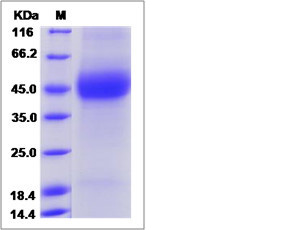Rat CD226 / DNAM-1 Protein (His Tag, ECD)
Cd226_predicted
- 100ug (NPP1014) Please inquiry
| Catalog Number | P80369-R08H |
|---|---|
| Organism Species | Rat |
| Host | Human Cells |
| Synonyms | Cd226_predicted |
| Molecular Weight | The recombinant rat Cd226 consists 245 amino acids and predicts a molecular mass of 28 kDa. |
| predicted N | Glu 32 |
| SDS-PAGE |  |
| Purity | > 95 % as determined by SDS-PAGE. |
| Protein Construction | A DNA sequence encoding the rat Cd226 (NP_001100840.1) (Met1-Ile265) was expressed with a polyhistidine tag at the C-terminus. |
| Bio-activity | |
| Research Area | Immunology |Cluster of Differentiation (CD) |T Cell CD Antigen |
| Formulation | Lyophilized from sterile PBS, pH 7.4. 1. Normally 5 % - 8 % trehalose and mannitol are added as protectants before lyophilization. Specific concentrations are included in the hardcopy of COA. |
| Background | The cluster of differentiation (CD) system is commonly used as cell markers in immunophynotyping. Different kinds of cells in the immune system can be identified through the surface CD molecules which associating with the immune function of the cell. There are more than 320 CD unique clusters and subclusters have been identified. Some of the CD molecules serve as receptors or ligands important to the cell through initiating a signal cascade which then alter the behavior of the cell. Some CD proteins do not take part in cell signal process but have other functions such as cell adhesion. CD226, also known as PTA1 or DNAM-1, is a member of the immunoglobulin superfamily containing 2 Ig-like domains of the V-set. High rate of CD226 (Cluster of Differentiation 226) is found on the surface of natural killer cells, platelets, monocytes and a subset of T cells. CD226 have binding sites with CD112 and CD155 and mediate cellular adhesion to other cells containing its ligands. |
| Reference |
